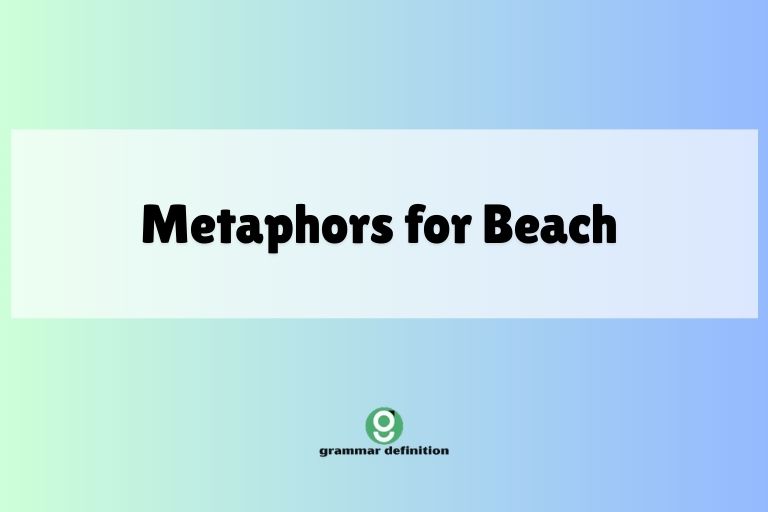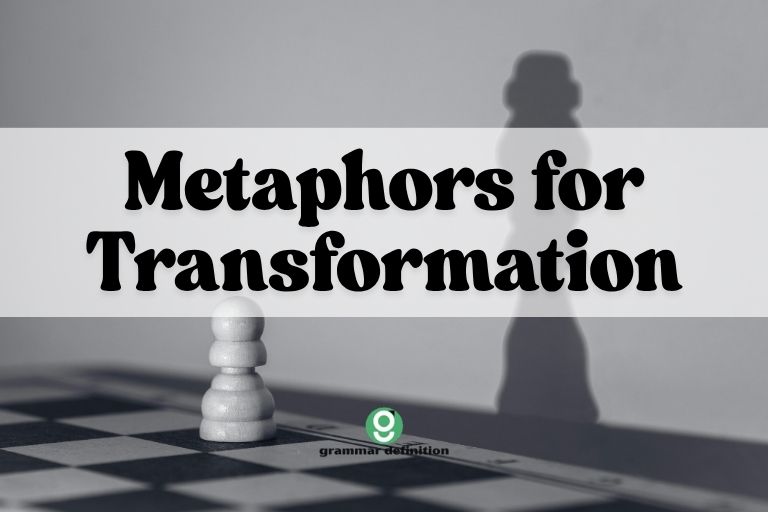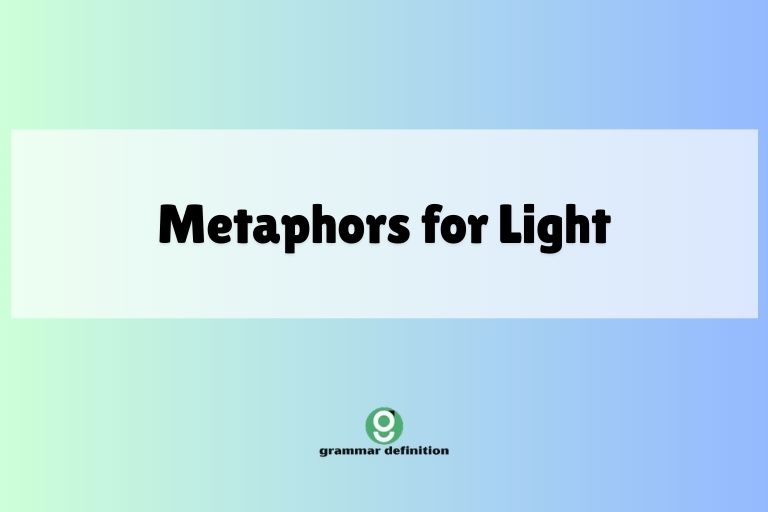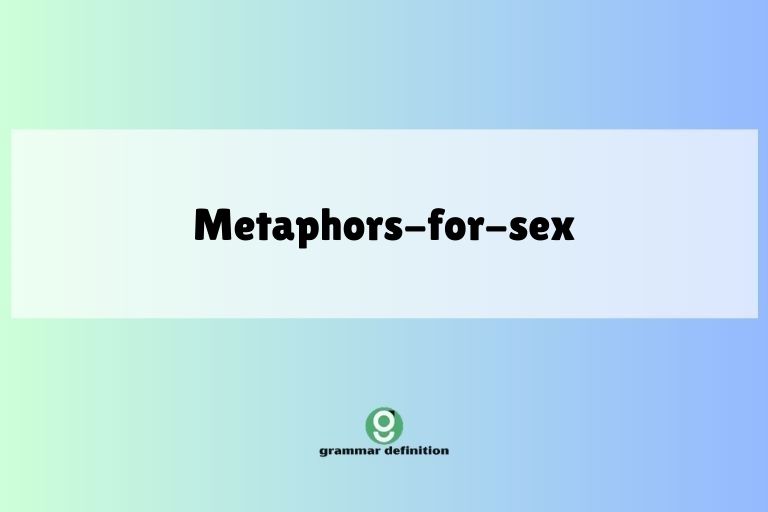Metaphors for War: A Comprehensive Guide
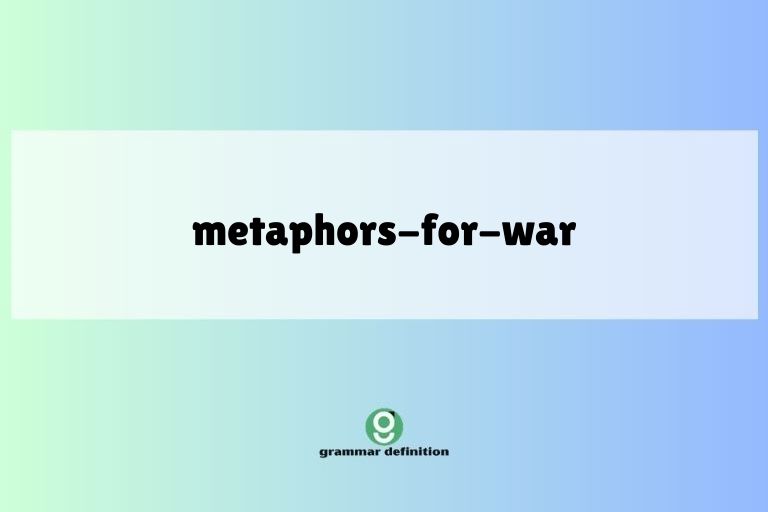
Understanding metaphors for war is crucial for interpreting political discourse, literature, and everyday communication. These metaphors shape our perceptions and emotional responses to conflict.
This guide explores various types of war metaphors, their structural elements, usage rules, and common pitfalls. It is designed for English language learners, students of rhetoric, and anyone interested in the power of language to influence thought and action.
Table of Contents
- Introduction
- Definition of Metaphor for War
- Structural Breakdown of War Metaphors
- Types of War Metaphors
- Examples of War Metaphors
- Usage Rules for War Metaphors
- Common Mistakes with War Metaphors
- Practice Exercises
- Advanced Topics in War Metaphors
- Frequently Asked Questions
- Conclusion
Definition of Metaphor for War
A metaphor for war uses language that normally describes warfare to characterize a different situation or concept. This involves transferring qualities, actions, or objects associated with war to the target domain, creating a vivid and often emotionally charged comparison.
These metaphors are not literal; they are figurative expressions that help us understand complex or abstract ideas through the lens of armed conflict.
Metaphors for war serve several functions. They can simplify complex issues, making them more accessible.
They can also frame a situation as urgent or critical, motivating action. Furthermore, they can evoke strong emotional responses, such as fear, anger, or determination.
The context in which a war metaphor is used greatly affects its interpretation and impact.
War metaphors can be found in various contexts, including political speeches, news articles, business reports, and everyday conversations. Understanding these metaphors is essential for critically evaluating the messages being conveyed.
Recognizing the underlying assumptions and implications of these metaphors allows us to form more informed opinions and make more thoughtful decisions.
Structural Breakdown of War Metaphors
The structure of a war metaphor typically involves two key elements: the source domain (war) and the target domain (the situation being described). The source domain provides the framework of warfare, while the target domain is the subject being illuminated by the metaphor. The metaphor works by mapping elements from the source domain onto the target domain.
For example, in the metaphor “the battle against cancer,” the source domain is war, and the target domain is the fight against cancer. Elements such as “battle,” “fighting,” and “weapons” are transferred from the source domain to the target domain.
This framing emphasizes the seriousness and intensity of the effort to overcome cancer.
The effectiveness of a war metaphor depends on the degree of conceptual overlap between the source and target domains. A strong metaphor highlights relevant similarities and creates a clear and compelling comparison.
A weak metaphor may be confusing or misleading if the connection between the domains is not readily apparent. The choice of specific war-related terms also influences the overall impact of the metaphor.
Types of War Metaphors
War metaphors take many forms, each emphasizing different aspects of warfare. Here are some common types:
War as a Game
This metaphor frames situations as strategic contests with winners and losers. It often involves terms like “strategy,” “tactics,” “maneuvers,” and “outflanking.” This type of metaphor can make a situation seem more manageable and predictable, but it may also downplay the seriousness of the consequences.
War as a Disease
This metaphor portrays a problem as an illness that needs to be eradicated. Terms like “epidemic,” “outbreak,” “infection,” and “cure” are commonly used.
This framing can evoke a sense of urgency and the need for aggressive intervention, but it may also lead to stigmatization or dehumanization.
War as a Natural Disaster
This metaphor presents a situation as an unavoidable and destructive force. Terms like “tsunami,” “earthquake,” “storm,” and “devastation” are often employed.
This framing can create a sense of helplessness and acceptance, but it may also discourage proactive efforts to mitigate the damage.
War as a Business
This metaphor views a situation through the lens of competition, profit, and loss. Terms like “market share,” “competitive advantage,” “takeover,” and “hostile acquisition” are frequently used.
This framing can emphasize efficiency and strategic planning, but it may also prioritize financial gains over ethical considerations.
War as a Sport
This metaphor portrays a situation as a competitive activity with rules, teams, and spectators. Terms like “game plan,” “opponent,” “victory,” and “defeat” are commonly used.
This framing can make a situation seem more exciting and engaging, but it may also trivialize the stakes involved.
War as a Crime
This metaphor frames a situation as a violation of laws or moral principles. Terms like “attack,” “violation,” “offense,” and “justice” are often employed.
This framing can evoke a sense of outrage and the need for accountability, but it may also lead to punitive measures that are disproportionate to the offense.
War as a Personal Struggle
This metaphor represents a situation as an individual’s fight against adversity. Terms like “battle,” “struggle,” “fight,” and “overcome” are commonly used.
This framing emphasizes resilience and determination, but it may also place undue pressure on individuals to succeed.
Examples of War Metaphors
The following tables provide examples of war metaphors across different categories. Each table contains a variety of examples to illustrate the diversity and range of these metaphors.
War as a Game Examples
This table illustrates how the language of games is used metaphorically to describe conflict and competition in various contexts.
| Metaphor | Context |
|---|---|
| The company launched a strategic offensive to capture market share. | Business |
| The political campaign was a chess match, with each candidate carefully planning their next move. | Politics |
| The negotiation turned into a high-stakes poker game. | Negotiation |
| The debate was a strategic game of cat and mouse. | Debate |
| The team executed a brilliant tactical maneuver to win the game. | Sports |
| The government is playing a dangerous game with the economy. | Economics |
| She outflanked her opponent with a clever argument. | Law |
| The merger was a carefully orchestrated strategic play. | Business |
| The legal battle was a long and complex game. | Law |
| He made a calculated gamble that paid off handsomely. | Finance |
| The project became a strategic endgame. | Project Management |
| The company’s marketing campaign was a masterclass in strategic positioning. | Marketing |
| The scientific community is engaged in a race to find a cure. | Science |
| Diplomacy is often a delicate game of give and take. | Diplomacy |
| The artist approached his work with a playful strategic mindset. | Art |
| The investor played the market like a grand chessmaster. | Finance |
| The environmental group launched a campaign to outmaneuver the developers. | Environmentalism |
| The teacher used a game-like approach to engage the students. | Education |
| The software company released a new version as a strategic upgrade. | Technology |
| Relationships can sometimes feel like a tactical dance. | Relationships |
| The cybersecurity firm is always playing a defensive game to protect its clients. | Cybersecurity |
| The social media influencer is leveraging strategic partnerships for growth. | Social Media |
| The CEO described the upcoming year as a critical period filled with tactical choices. | Business |
| The detective used a subtle game of interrogation to uncover the truth. | Criminal Justice |
| The author crafted the plot with strategic twists and turns. | Literature |
War as a Disease Examples
This table showcases instances where problems are framed as diseases requiring eradication, often highlighting their pervasive and harmful nature.
| Metaphor | Context |
|---|---|
| The company is fighting to eradicate corruption from its ranks. | Business |
| Poverty is a social disease that needs to be cured. | Sociology |
| The spread of misinformation is an epidemic on social media. | Social Media |
| Racism is a deeply rooted infection in our society. | Sociology |
| The government is launching a campaign to combat the obesity epidemic. | Public Health |
| The rise of extremism is a dangerous outbreak of hatred. | Politics |
| The company is working to immunize itself against future crises. | Business |
| Addiction is a disease that requires treatment and support. | Psychology |
| The project was plagued by a virus of inefficiency. | Project Management |
| The city is struggling to contain the spread of crime. | Urban Planning |
| The scandal threatened to infect the entire organization. | Business Ethics |
| The economic downturn was a severe ailment affecting the entire nation. | Economics |
| The political climate is suffering from a toxic disease of division. | Politics |
| The company implemented measures to prevent a recurrence of the financial infection. | Finance |
| The community is battling an epidemic of loneliness. | Community Health |
| The spread of fake news is a dangerous contagion. | Media Studies |
| The organization is committed to rooting out the disease of discrimination. | Human Resources |
| The team worked tirelessly to find a cure for the project’s problems. | Project Management |
| The artist used his work to expose the societal virus of consumerism. | Art |
| The scientist dedicated her life to finding a vaccine against the disease of ignorance. | Education |
| The nonprofit organization is devoted to curing the world of hunger. | Philanthropy |
| The environmental activist is fighting to heal the planet from the disease of pollution. | Environmentalism |
| The therapist specializes in helping people recover from the infection of trauma. | Psychology |
| The journalist uncovered the hidden symptoms of corruption. | Journalism |
| The activist group is working to quarantine the sources of hate speech. | Social Activism |
War as a Natural Disaster Examples
This table presents situations described as unavoidable and destructive natural events, often highlighting their catastrophic impact.
| Metaphor | Context |
|---|---|
| The market crash was a financial tsunami that swept away fortunes. | Finance |
| The company was hit by a perfect storm of economic challenges. | Business |
| The political scandal unleashed a hurricane of controversy. | Politics |
| The project was derailed by an avalanche of unforeseen problems. | Project Management |
| The city was ravaged by a flood of crime and violence. | Urban Planning |
| The company weathered the storm of the recession. | Economics |
| The relationship was destroyed by a volcanic eruption of anger. | Relationships |
| The community was devastated by the earthquake of social change. | Sociology |
| The industry was shaken by a seismic shift in technology. | Technology |
| The negotiations were stalled by a blizzard of disagreements. | Diplomacy |
| The artist’s career was swept away in a tidal wave of criticism. | Art |
| The political landscape was reshaped by a landslide victory. | Politics |
| The company was buried under an avalanche of debt. | Finance |
| The relationship ended in a fiery inferno of resentment. | Relationships |
| The project was consumed by a wildfire of scope creep. | Project Management |
| The community was overwhelmed by a deluge of refugees. | Sociology |
| The company faced a torrent of negative publicity. | Public Relations |
| The political party was engulfed in a whirlwind of internal conflict. | Politics |
| The city was paralyzed by a snowstorm of bureaucratic red tape. | Urban Planning |
| The artist’s work was ignited by a spark of inspiration. | Art |
| The company was caught in a vortex of financial instability. | Finance |
| The country was plunged into darkness by a blackout of information. | Media Studies |
| The relationship was shattered by a thunderclap of betrayal. | Relationships |
| The project was washed away by a flood of unforeseen circumstances. | Project Management |
| The community was frozen by a deep freeze of economic stagnation. | Economics |
Usage Rules for War Metaphors
When using war metaphors, it is important to consider the potential impact on your audience. Here are some rules to guide your usage:
- Be mindful of the context: War metaphors can be highly emotive, so use them judiciously and ensure they are appropriate for the situation.
- Avoid trivializing serious issues: Do not use war metaphors to describe minor inconveniences or disagreements.
- Consider the ethical implications: Be aware that war metaphors can normalize violence and aggression.
- Ensure clarity and relevance: The connection between the source and target domains should be clear and meaningful.
- Be sensitive to cultural differences: War metaphors may have different connotations in different cultures.
Exceptions to these rules may arise in specific contexts, such as creative writing or satire, where the deliberate use of inappropriate or exaggerated metaphors can be used for artistic effect. However, in most cases, it is best to err on the side of caution and use war metaphors responsibly.
Common Mistakes with War Metaphors
Here are some common mistakes people make when using war metaphors:
| Incorrect | Correct | Explanation |
|---|---|---|
| “I’m battling a headache.” | “I’m dealing with a headache.” | Using “battling” trivializes the concept of war. |
| “The project was a war.” | “The project was a challenging endeavor.” | The metaphor is too vague and lacks specificity. |
| “We must nuke the competition.” | “We must outperform the competition.” | The metaphor is overly aggressive and unethical. |
| “The presentation was an all-out war zone.” | “The presentation was chaotic and disorganized.” | The metaphor is exaggerated and inappropriate. |
| “I’m fighting to get out of bed.” | “I’m struggling to get out of bed.” | “Fighting” is too strong for a mundane activity. |
To avoid these mistakes, always consider the connotations of the war-related terms you are using and ensure they are appropriate for the context. Choose metaphors that are clear, relevant, and ethically sound.
Practice Exercises
Test your understanding of war metaphors with these exercises.
Exercise 1: Identifying War Metaphors
Identify the war metaphor in each sentence and explain its effect.
| Question | Answer |
|---|---|
| 1. The company launched an aggressive campaign to dominate the market. | “Aggressive campaign” – frames business as a battle. |
| 2. The politician declared war on poverty. | “Declared war” – frames poverty as an enemy. |
| 3. The team fought hard to win the championship. | “Fought hard” – frames sports as a battle. |
| 4. The debate was a battle of wits. | “Battle of wits” – frames debate as armed conflict. |
| 5. The project was besieged by problems. | “Besieged” – frames project as a city under attack. |
| 6. She defended her thesis with unwavering conviction. | “Defended” – frames academic work as protection against attack. |
| 7. The government is waging a war on drugs. | “Waging a war” – frames drug use as an enemy to be defeated. |
| 8. The artist is battling his inner demons. | “Battling” – frames personal struggles as a fight. |
| 9. The company is on the front lines of innovation. | “Front lines” – frames business as a war zone of creativity. |
| 10. They are struggling to survive the economic downturn. | “Struggling to survive” – frames the economy as a dangerous environment. |
Exercise 2: Rewriting Sentences
Rewrite the following sentences to remove the war metaphors.
| Question | Answer |
|---|---|
| 1. The company launched a blitzkrieg of marketing campaigns. | The company launched a series of intense marketing campaigns. |
| 2. The negotiations were a battlefield of conflicting interests. | The negotiations were fraught with conflicting interests. |
| 3. He attacked the problem with a vengeance. | He addressed the problem with great determination. |
| 4. The project was a minefield of potential errors. | The project was fraught with potential errors. |
| 5. She conquered her fear of public speaking. | She overcame her fear of public speaking. |
| 6. The team fortified their defenses against the competition. | The team strengthened their safeguards against the competition. |
| 7. The company is under siege from activist investors. | The company is facing pressure from activist investors. |
| 8. The government is battling to control inflation. | The government is striving to control inflation. |
| 9. The artist is waging war against conformity. | The artist is challenging conformity. |
| 10. They are digging in for a long fight. | They are preparing for a sustained effort. |
Exercise 3: Creating War Metaphors
Create your own war metaphors to describe the following situations.
| Situation | Example Metaphor |
|---|---|
| A difficult exam | The exam was an uphill battle against the clock. |
| A challenging relationship | The relationship was a constant tug-of-war. |
| A competitive job market | The job market is a fierce arena where only the strongest survive. |
| A creative project | The project was a campaign to conquer new artistic territory. |
| A personal goal | Achieving my goal is a war against my own limitations. |
| Overcoming a bad habit | Breaking the habit is a siege against my own cravings. |
| Dealing with bureaucracy | Navigating the bureaucracy is like wading through a minefield. |
| Negotiating a deal | The negotiation was a strategic dance of power. |
| Resolving a conflict | Reconciliation is a ceasefire after a long struggle. |
| Starting a new business | Launching the business is a daring raid on the market. |
Advanced Topics in War Metaphors
For advanced learners, consider exploring the following topics:
- The role of war metaphors in political propaganda: Analyze how war metaphors are used to manipulate public opinion and justify political actions.
- The impact of war metaphors on conflict resolution: Investigate how war metaphors can hinder or facilitate peaceful solutions to conflicts.
- The use of war metaphors in different cultural contexts: Compare and contrast how war metaphors are used in different cultures and languages.
- The evolution of war metaphors over time: Trace the historical development of war metaphors and their changing meanings.
- The ethical implications of using war metaphors in specific domains: Discuss the ethical considerations of using war metaphors in areas such as healthcare, education, and business.
Further research into these areas will deepen your understanding of war metaphors and their broader implications.
Frequently Asked Questions
Here are some frequently asked questions about war metaphors:
- What is the difference between a metaphor and a simile?
A metaphor directly equates two things, while a simile uses “like” or “as” to make a comparison. For example, “He is a lion” (metaphor) vs. “He is like a lion” (simile).
- Why are war metaphors so common?
War metaphors are common because conflict is a fundamental aspect of human experience. They provide a readily understandable framework for describing challenges and struggles.
- Can war metaphors be harmful?
Yes, war metaphors can normalize violence, oversimplify complex issues, and evoke negative emotions. It’s crucial to use them thoughtfully and responsibly.
- How can I identify war metaphors in everyday language?
Look for language that describes a situation using terms typically associated with warfare, such as “battle,” “fight,” “attack,” or “defense.” Consider whether the comparison is literal or figurative.
- Are there alternatives to war metaphors?
Yes, there are many alternatives, such as metaphors based on games, journeys, or natural processes. The best alternative depends on the specific context and the message you want to convey.
- How do war metaphors affect our perception of reality?
War metaphors can shape our perception of reality by framing situations as adversarial and urgent. This can influence our emotional responses and decision-making processes.
- What role do war metaphors play in political discourse?
War metaphors are frequently used in political discourse to mobilize support, demonize opponents, and justify policies. They can be powerful tools for persuasion and manipulation.
- How can I use war metaphors more effectively?
Use war metaphors sparingly and with careful consideration of their potential impact. Ensure they are clear, relevant, and ethically sound. Be mindful of the context and your audience.
Conclusion
Metaphors for war are powerful linguistic tools that can shape our understanding of complex situations. By recognizing and analyzing these metaphors, we can gain a deeper insight into the messages being conveyed and their potential impact.
Understanding the structure, types, and usage rules of war metaphors is essential for effective communication and critical thinking.
As you continue to explore the English language, pay attention to the metaphors that are used around you. Consider their implications and how they influence your perceptions.
With practice, you can become more adept at using metaphors effectively and interpreting them critically. Remember that the responsible use of language is key to fostering understanding and promoting constructive dialogue.

